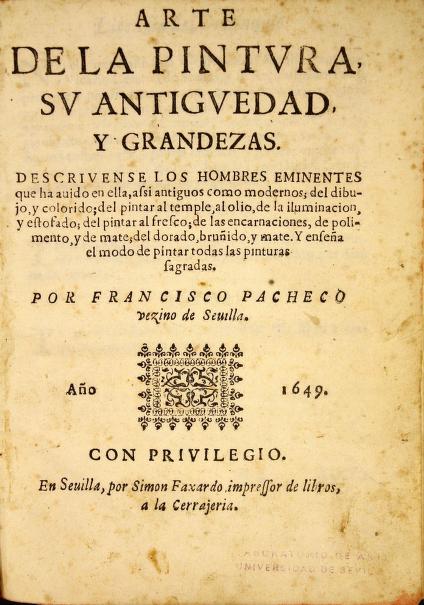
Frostispiece of Pacheco, El Arte de la pintura (1649), Seville, Simon Faxardo, impressor de libros, a la Cerrajeria
Pacheco while analysing the painting of the Sacred Mystery, quoted a passage of Father Martin de Roa (1623, cap. 3, 14r-14v) condemning not only the representation of it as a man with three faces, or heads, in the manner of Janus or Gerin, but also the artist who made it: made sane people scandalised, as well as made the ignorant man fall into error. Pacheco quoted Molanus too (Book 2, ch.4. pp.36-37), who further condemned such iconography calling it “diabolical fiction”: following the author, Pacheco told the story of the devil who appeared in this form to a religious saint in the year of 1221, assuring the saint that it was the Holy Trinity, but, the saint, with light from heaven, recognized the deception and, cursing him, cast him out.
“Starting, then, in the name of the Holy Trinity, with the painting of this Sacred Mystery, Father Martin de Roa reprehends an image of it, in which a man with three faces, or heads, is represented, in the manner of Janus or Gerión, with which sane people are scandalized and makes the ignorant err. But Juan Molano makes it even more ugly, calling this painting “diabolical fiction”, and tells that the devil appeared in this form to a religious saint, in the year 1221, assuring him that it was the Holy Trinity, but, he, with light from heaven, did he recognize the deception and, cursing him, cast him out”.
“Comenzando, pues, en el nombre de la Santísima Trinidad, por la pintura deste Sacrosanto misterio, el P. Martin de Roa reprehende una imagen dél, en que se representa un hombre con tres rostros, o cabezas, a la manera de Jano o Gerión, con que se escandaliza la gente cuerda y hace errar a los ignorantes. Pero, Juan Molano la afea muncho más, llamando a esta pintura «ficción diabólica», y cuenta que se apareció el demonio en esta forma a un santo religioso, año de 1221, asegurándole que era la Santísima Trinidad, mas, él, con luz del cielo, reconoció el engaño y, maldiciéndolo, lo echó de sí.”



